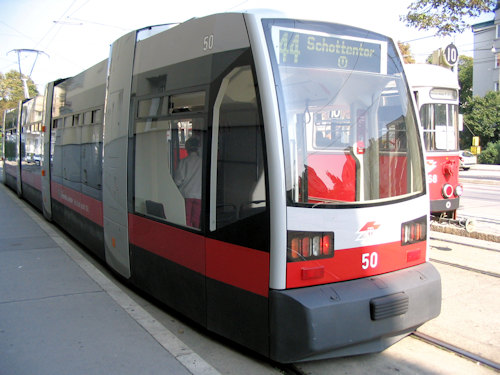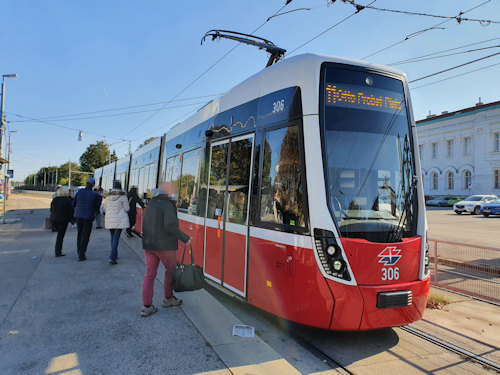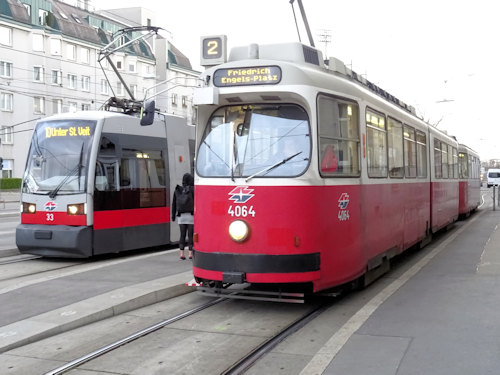
Trams are perhaps the most frequent form of surface public transport in Vienna, and the tram system dates back to the 1800s. (I should point out that one or two upgrades have taken place since then.)
- See also:
The Vienna tram system

(Most trams take this Niederflur design, with easy accessibility through raised platforms and a low entry height)
Viennese trams are easy to spot, being large, unsurprisingly tram-shaped, traveling along rails, and decked out in the distinctive red and white(ish) colours of Vienna.
The German for tram is Straßenbahn (literally “street railway”), though the slang term Bim is equally common and even used at times by the Wiener Linien municipal transport authorities.
Just under 30 standard Wiener Linien tram services operate, and your public transport ticket is valid for all of them.
According to Wiener Linien, the Vienna tram network covers around 171km. This makes it the sixth-largest tram network in the world. (Melbourne claims to be the largest.)
Each line draws its power from overhead electric cables and has a number or letter designation (e.g. 9 or D). Most trams run from the early morning until after midnight, with special night (bus) services also operating on selected routes.
During the bulk of the day, intervals between trams are generally 4-8 minutes, with delays rare. Vienna is geared up for snow, so there have to be serious blizzards to keep the vehicles off the road.
Important lines for visitors

(One of the very latest Flexity trams to join the fleet, but not yet a common sight)
The lines of most interest to visitors are those that travel along part of the Ring boulevard that encircles the old town (no trams actually enter the old town):
- Line 1: travels between the Prater recreational area and the south of the city via much of the Ring
- Line D: also travels around parts of the Ring and runs between the main railway station, the Belvedere palaces and the north
- Line 71: another “Ring” tram that starts in the centre and continues out past Belvedere to the Zentralfriedhof cemetery and its famous composer graves
- Line 2: the final “Ring” tram goes from the banks of the Danube down to (and round much of) the city centre, then out to the west of Vienna
The 2 tram is a mysterious and magical beast much like Harry Potter’s Knight Bus. It feels like you could be anywhere in the city and suddenly find yourself next to a tram stop for the 2.
Three trams operate outside the normal system: the yellow sightseeing tram, the Manner tram, and the Ströck Christmas tram. None have been running of late, but I can’t rule out a return (check locally).
Using trams

(Old and new trams)
Vienna has largely (but not completely) migrated from the old-style trams (see the picture of the number 2 above) to the new Niederflur trams. An even newer Flexity tram generation is on its way and already in operation on selected lines.
(If you’re interested in old-timer transport vehicles, then I recommend you visit the city’s Transport Museum.)
The modern trams are low-lying with raised tram stop platforms, so you can push a pram or wheelchair straight on without going up steps. These trams also have dedicated areas for those wheelchairs and prams (with even more space available in the new Flexity models).
There are no special rules of the road for using a tram, but here a couple of tips:
- Seats marked with coloured symbols for the old, the handicapped, pregnant women or parents with young kids should be kept free for the same. You can sit there, but you should (obviously) move as soon as someone fitting the above descriptions gets on board and needs your seat
- Same goes for those areas marked for wheelchair users or prams. You can occupy the space, but be prepared to move if needed
- As you approach your stop, you press the exit button on any door to warn the driver
In reality, there’s nearly always someone waiting so the tram will almost certainly stop anyway, but you might need to press the button to get the door to actually open when the tram eventually comes to a standstill.
- Similarly, if you’re waiting at a tram stop and the tram arrives but nobody gets off at the door nearest you, then press the button on the outside to board
- Older trams have a list of stops displayed somewhere on board. Newer ones have screens telling you which stops are coming up. The next stop is normally announced over a loudspeaker, too
Driving around trams

(A royal tram from 1900…no longer in operation)
If you’re driving in Vienna, be aware that the trams are the royalty of the road. Two things to remember in particular:
- Some tram lines follow the road, so you can’t help but drive along the same route. But don’t block a line unless you have no choice: trams don’t take kindly to unnecessary delays and are bigger than you. They also have right of way
- Most importantly, you may find yourself on a lane running between a tram and a tram stop, so you’re driving more or less alongside a tram in the same direction. Once the tram is nearing or at a stop, you must stop, too, even if the road ahead is clear.
You can only pass the tram’s right side at or near a stop if no people are boarding or leaving the tram, nobody is looking to board the tram, and the vehicle’s doors are all shut. To be safe, simply stop until the tram starts to move off again.